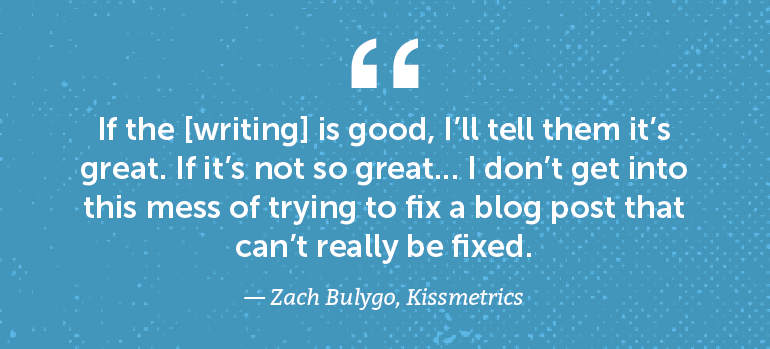How To Manage The Best Blog In Your Niche With Zach Bulygo From Kissmetrics [AMP 049]
 Successful content marketing depends on publishing great content consistently. Do you know how to know what’s working and what’s not? More importantly, can you learn as you go so you can improve your future blog posts?
Today, we’re talking to Zach Bulygo, the blog manager at Kissmetrics. We’ll talk about Zach’s process and planning, how to work with guest writers, how to publish lots of content with a small team, and how to turn your marketing blog into a leading authority. Sit back, relax, and get read to glean a ton of great information from Zach.
Some of the highlights of the show include:
Successful content marketing depends on publishing great content consistently. Do you know how to know what’s working and what’s not? More importantly, can you learn as you go so you can improve your future blog posts?
Today, we’re talking to Zach Bulygo, the blog manager at Kissmetrics. We’ll talk about Zach’s process and planning, how to work with guest writers, how to publish lots of content with a small team, and how to turn your marketing blog into a leading authority. Sit back, relax, and get read to glean a ton of great information from Zach.
Some of the highlights of the show include:
- Some information about Kissmetrics and what Zach does there, as well as what topics are covered on the Kissmetrics blog.
- Why the team as Kissmetrics embraces guest posts and how those fit into the site’s strategy.
- The goals of the Kissmetrics blog and how the team uses data analysis and testing to achieve them.
- How Zach uses data to know that the blog posts and CTAs are working and how the information helps the team tweak future blogs for more success.
- The standards that the Kissmetrics team holds its guest writers to.
- How Zach manages the blog as the only permanent person on the team.
- The typical workflow for a blog post on Kissmetrics.
- Zach’s advice for a marketing team that is hoping to add blog content to their marketing mix.
- “If the [writing] is good, I’ll tell them it’s great. If it’s not so great... I don’t get into this mess of trying to fix a blog post that can’t really be fixed.”
- “You should already have an idea of who your ideal customer prospect is.”
- “Google Analytics is not the most exciting platform... add a little bit of humor where possible. Just mix that humor with useful information with images and keep the writing flowing well.”
How To Manage The Best Blog In Your Niche With Zach Bulygo From Kissmetrics
Click To Tweet Nathan: Something you mentioned earlier was that you guys focus on actionable content. Tell me about that. What do you look for in that sort of quality?
Zach: I try to avoid listicles. I try to avoid, “Here’s 100 ways you can increase your ecommerce revenue,” because that’s long and people don’t want to read it. Most of it is just stuff that’s been discussed before. What I like is actual content that’s step by step. We’re showing people how to use a new report in Google Analytics, for example, or we’re going to show them step by step literally, here is what you click on to get there and then the images will have arrows that point to everything, to show them the way around the report. That would be what I look for in an actionable blog post.
Nathan: Obviously, you’re publishing lots of really great content. About how many blog posts do you publish in a given week?
Zach: Three to five.
Nathan: How big is the team that helps you create that much content?
Zach: I’m the only person in Kissmetrics that works for the blog but I have three or four paid writers that I work with and then the rest is filled in either by me or our guest writers. Our paid writers, I can usually get about two to four posts a month out of each of them. It’s usually enough for three a week. Like I said, the rest is filled in by guest writers or by me. When I’m not editing or brainstorming with writers, I’m usually writing blog posts myself.
Nathan: Tell me. Is there a secret to publishing that much content with just one person? Tell me about that.
Zach: I guess there’s no secret. It’s just having a good team of writers around me. I really like the paid writers that I have. They’re consistent. They make my job easier because there are usually not too many rounds of revision that we have to go through. In many cases, there’s none. They send it to me. I read it. I like it. Sometimes, I’ll make small edits myself to the blog post but that’s not too often. They really help me out a lot. The good guest writers are really helpful as well so long as they’re quick to respond to revisions and emails.
I can usually whip out a blog post in maybe five or six hours if I’m really focused and I don’t have any distractions and other stuff. I can usually get one out a week if I’m not too busy.
Nathan: Three to five pieces is a lot every single week. How far ahead of schedule are you planning that blog content?
Zach: It’s not far at all. I think the farthest I’ve had it out was two weeks. That is the farthest. If I’m working on a Friday, I’m going to figure out what I’m going to publish the next week, I’ll have three or four that are ready to go from the paid writers. That gives me Monday, Tuesday, maybe Wednesday. I got these three other guest writers that I’m working with. I hope we can finish this up so I can get it published Thursday or Friday. My pipeline is not large at all. I can only plan out maybe a few days ahead. It’s tough.
Nathan: Why do you like to have a shorter time frame from getting the post to publishing it?
Zach: I would love to have a huge pipeline of posts. I would love to be able to have 15 that are ready to go. That would be awesome. But I have to work with the blog budget that I have, which limits the amount of blog posts I can accept and like I said before, the guest post submissions that I receive usually are good. I only accept a couple of them a week and some of those don’t turn out to be very good. I would love to have 15 but I’m just usually not that full. I would be if I didn’t publish three to five times a week but we like to publish pretty often.
Nathan: You’re working through lots of different pieces in a given week. Typical workflow, what does that look like for a blog post at Kissmetrics?
Zach: We have paid writers. It’s pretty simple. They’ll send in topic ideas or I’ll send topic ideas for them, and then we agree on a few of them, three or four maybe. We skip the outlines for paid writers because no need for it except for maybe one or two of them. They’ll send me a Google Doc and then I’ll read through it. I’ll make comments along the way. I’ll finish it. I’ll send an email saying, “Feedback added. Let me know what you think.” They’ll get through it, they’ll make any changes, and then I’ll publish it when it’s available.
For guest writers, it’ a little bit different because they go through the form and then they got to send in the outline and then we got to work through the draft. Those usually take a little bit longer. We’ll collaborate in a Google Doc, make comments, make changes together. In some cases, I’m more heavy handed with the editing because it’s just easier for me to make changes instead of just asking them because I’ll just note like, “Oh, can you add this?” If I get the sense that what they add may not be great, then I’ll just add it in myself or make any edits myself. They usually don’t mind.
If the stuff is good, I’ll be honest with them. I’ll tell them it’s great. I’ll praise it. If it’s not so great, then like I said earlier, I have to be able to spot that early so I don’t get thrown into this mess of trying to fix a blog post that can’t really be fixed. So yeah, and then we’ll make those revisions and I’ll get it published.
Nathan: Something you mentioned earlier was that you guys focus on actionable content. Tell me about that. What do you look for in that sort of quality?
Zach: I try to avoid listicles. I try to avoid, “Here’s 100 ways you can increase your ecommerce revenue,” because that’s long and people don’t want to read it. Most of it is just stuff that’s been discussed before. What I like is actual content that’s step by step. We’re showing people how to use a new report in Google Analytics, for example, or we’re going to show them step by step literally, here is what you click on to get there and then the images will have arrows that point to everything, to show them the way around the report. That would be what I look for in an actionable blog post.
Nathan: Obviously, you’re publishing lots of really great content. About how many blog posts do you publish in a given week?
Zach: Three to five.
Nathan: How big is the team that helps you create that much content?
Zach: I’m the only person in Kissmetrics that works for the blog but I have three or four paid writers that I work with and then the rest is filled in either by me or our guest writers. Our paid writers, I can usually get about two to four posts a month out of each of them. It’s usually enough for three a week. Like I said, the rest is filled in by guest writers or by me. When I’m not editing or brainstorming with writers, I’m usually writing blog posts myself.
Nathan: Tell me. Is there a secret to publishing that much content with just one person? Tell me about that.
Zach: I guess there’s no secret. It’s just having a good team of writers around me. I really like the paid writers that I have. They’re consistent. They make my job easier because there are usually not too many rounds of revision that we have to go through. In many cases, there’s none. They send it to me. I read it. I like it. Sometimes, I’ll make small edits myself to the blog post but that’s not too often. They really help me out a lot. The good guest writers are really helpful as well so long as they’re quick to respond to revisions and emails.
I can usually whip out a blog post in maybe five or six hours if I’m really focused and I don’t have any distractions and other stuff. I can usually get one out a week if I’m not too busy.
Nathan: Three to five pieces is a lot every single week. How far ahead of schedule are you planning that blog content?
Zach: It’s not far at all. I think the farthest I’ve had it out was two weeks. That is the farthest. If I’m working on a Friday, I’m going to figure out what I’m going to publish the next week, I’ll have three or four that are ready to go from the paid writers. That gives me Monday, Tuesday, maybe Wednesday. I got these three other guest writers that I’m working with. I hope we can finish this up so I can get it published Thursday or Friday. My pipeline is not large at all. I can only plan out maybe a few days ahead. It’s tough.
Nathan: Why do you like to have a shorter time frame from getting the post to publishing it?
Zach: I would love to have a huge pipeline of posts. I would love to be able to have 15 that are ready to go. That would be awesome. But I have to work with the blog budget that I have, which limits the amount of blog posts I can accept and like I said before, the guest post submissions that I receive usually are good. I only accept a couple of them a week and some of those don’t turn out to be very good. I would love to have 15 but I’m just usually not that full. I would be if I didn’t publish three to five times a week but we like to publish pretty often.
Nathan: You’re working through lots of different pieces in a given week. Typical workflow, what does that look like for a blog post at Kissmetrics?
Zach: We have paid writers. It’s pretty simple. They’ll send in topic ideas or I’ll send topic ideas for them, and then we agree on a few of them, three or four maybe. We skip the outlines for paid writers because no need for it except for maybe one or two of them. They’ll send me a Google Doc and then I’ll read through it. I’ll make comments along the way. I’ll finish it. I’ll send an email saying, “Feedback added. Let me know what you think.” They’ll get through it, they’ll make any changes, and then I’ll publish it when it’s available.
For guest writers, it’ a little bit different because they go through the form and then they got to send in the outline and then we got to work through the draft. Those usually take a little bit longer. We’ll collaborate in a Google Doc, make comments, make changes together. In some cases, I’m more heavy handed with the editing because it’s just easier for me to make changes instead of just asking them because I’ll just note like, “Oh, can you add this?” If I get the sense that what they add may not be great, then I’ll just add it in myself or make any edits myself. They usually don’t mind.
If the stuff is good, I’ll be honest with them. I’ll tell them it’s great. I’ll praise it. If it’s not so great, then like I said earlier, I have to be able to spot that early so I don’t get thrown into this mess of trying to fix a blog post that can’t really be fixed. So yeah, and then we’ll make those revisions and I’ll get it published.
 Nathan: Just because you work at Kissmetrics and you’re doing some of these data analyses to understand what sorts of topics you should cover, what’s one of the most interesting things you’ve done with data to improve your marketing?
Zach: I found that Google [00:22:13] too well. They bring in qualified traffic obviously because they’re interested in analytics and we’re an analytics company and with some engagement. A lot of people don’t really know the difference between Google Analytics and Kissmetrics so what I’ve done is I’ve written a blog post that outlines the difference. That gets a lot of pageviews, I think that if you would type into Google like [00:25:01], it would be right there at the top.
But what I also did was I worked with a paid writer that I had to publish an ebook that explains where Google Analytics is missing and how Kissmetrics can fill the gaps they leave behind. This one performed very well by almost any measure. It got a lot of downloads. It brought sign ups, it brought leads, and it even brought a few customers. I don’t think I would have started this project with the paid writer if I did not actually look at this data and see so clearly what needs to be written. I would say that’s the most interesting thing.
I’ve also learned what not to publish: social media. I think if we talk about ourselves too much, our own product, I think that would send people away. Usually, that stuff doesn’t get a whole lot of views either. That’s what I’ve learned.
Nathan: For a marketing team that’s looking to add blog content in their marketing mix, maybe they’re not doing it or maybe they’re not looking at the data, what would you recommend they do to kick it off and be successful at maintaining their blog?
Zach: You should already have an idea of who your ideal customer prospect is. You should have those personas on hand. I would use that to figure out what types of content you want to publish. We did this. We figured out who, we call them gold customers, we figure out who those people were, we talk to them, we figure out what challenges they have, where do they get information from, what do they like to read about that’s in tech, and then I use that to sort of formulate future content or content strategy. That’s what I would recommend that people do.
Nathan: Just because you work at Kissmetrics and you’re doing some of these data analyses to understand what sorts of topics you should cover, what’s one of the most interesting things you’ve done with data to improve your marketing?
Zach: I found that Google [00:22:13] too well. They bring in qualified traffic obviously because they’re interested in analytics and we’re an analytics company and with some engagement. A lot of people don’t really know the difference between Google Analytics and Kissmetrics so what I’ve done is I’ve written a blog post that outlines the difference. That gets a lot of pageviews, I think that if you would type into Google like [00:25:01], it would be right there at the top.
But what I also did was I worked with a paid writer that I had to publish an ebook that explains where Google Analytics is missing and how Kissmetrics can fill the gaps they leave behind. This one performed very well by almost any measure. It got a lot of downloads. It brought sign ups, it brought leads, and it even brought a few customers. I don’t think I would have started this project with the paid writer if I did not actually look at this data and see so clearly what needs to be written. I would say that’s the most interesting thing.
I’ve also learned what not to publish: social media. I think if we talk about ourselves too much, our own product, I think that would send people away. Usually, that stuff doesn’t get a whole lot of views either. That’s what I’ve learned.
Nathan: For a marketing team that’s looking to add blog content in their marketing mix, maybe they’re not doing it or maybe they’re not looking at the data, what would you recommend they do to kick it off and be successful at maintaining their blog?
Zach: You should already have an idea of who your ideal customer prospect is. You should have those personas on hand. I would use that to figure out what types of content you want to publish. We did this. We figured out who, we call them gold customers, we figure out who those people were, we talk to them, we figure out what challenges they have, where do they get information from, what do they like to read about that’s in tech, and then I use that to sort of formulate future content or content strategy. That’s what I would recommend that people do.
 Make those assumptions based off of your personas that you have and then you start writing posts, start to get a good amount of traffic. Maybe once you have let’s say 10,000 people at your blog every month, I think that’s enough to where a couple of hundred blog posts. I think you’ll have enough to where you can then look into the data and validate those assumptions that you previously made based off of your personas. Usually, it should line up. If it doesn’t, data doesn’t lie, so you know where to go. I would rely on data and looking at what people are viewing before they sign up because that will really, really help you in forming your content strategy.
Nathan: Nice. I think that’s awesome advice, Zach, and probably a great place to wrap this up. I just want to say thanks for being on the podcast today. This was awesome.
Zach: Yeah, you bet. Had a good time. Thanks.
Nathan: At CoSchedule, we analyze our blog post following a really similar process to Zach’s. When we replicated the qualities of our most successful blog posts in new ones, we were able to boost our results as much as 9,360%, really. To top it off, that process helped us understand what to stop doing. All of that helped us generate bigger results with the same amount of effort.
Zach, thanks so much for sharing your thoughts on blog management with us today on the Actionable Marketing Podcast. Thanks to you to for tuning into this episode. You just heard from Zach Bulygo. He is the blog manager at Kissmetrics.
Make those assumptions based off of your personas that you have and then you start writing posts, start to get a good amount of traffic. Maybe once you have let’s say 10,000 people at your blog every month, I think that’s enough to where a couple of hundred blog posts. I think you’ll have enough to where you can then look into the data and validate those assumptions that you previously made based off of your personas. Usually, it should line up. If it doesn’t, data doesn’t lie, so you know where to go. I would rely on data and looking at what people are viewing before they sign up because that will really, really help you in forming your content strategy.
Nathan: Nice. I think that’s awesome advice, Zach, and probably a great place to wrap this up. I just want to say thanks for being on the podcast today. This was awesome.
Zach: Yeah, you bet. Had a good time. Thanks.
Nathan: At CoSchedule, we analyze our blog post following a really similar process to Zach’s. When we replicated the qualities of our most successful blog posts in new ones, we were able to boost our results as much as 9,360%, really. To top it off, that process helped us understand what to stop doing. All of that helped us generate bigger results with the same amount of effort.
Zach, thanks so much for sharing your thoughts on blog management with us today on the Actionable Marketing Podcast. Thanks to you to for tuning into this episode. You just heard from Zach Bulygo. He is the blog manager at Kissmetrics.




